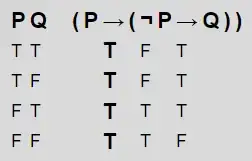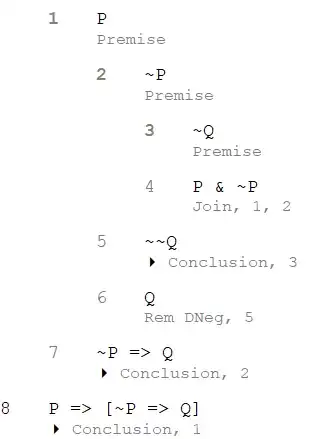Question
Is the following statement true?
For all statements p, p always being false implies that for all statements q, p implies q, i.e:
$$\forall p(\lnot p \implies \forall q(p \implies q))$$
If so, why? If not, why not?
Thanks.
Attempt
Here's my attempt of explaining why I think that the above statement is true. I am new to this notation, so pardon me if I made any mistakes.
Assumption 1:
For all statements p, p does not imply q when there exists a statement r, where r implies p but also implies not q.
$$\forall p(p \nRightarrow q) \equiv \exists r((r \implies p) \land (r \implies \lnot q))$$
Assumption 2:
If we've disproven that p does not imply q, then p implies q.
$$\lnot(p \nRightarrow q) \implies (p \implies q) $$
Proof:
$p$ is always false, therefore there does not exist $r$ such that $r \implies p$
Therefore, there does not exist $r$ such that $(r \implies p) \land (r \implies \lnot q)$
Therefore, based on assumption 1 above, the statement $p \nRightarrow q$ is false
Therefore, based on assumption 2 above, $p \implies q$
However, my two assumptions could be wrong! It's also messy that I am defining logic using logic.
Context
Here is a proof I was told for the following statement in relation to sets, which goes on the assumption that my statement at the beginning of this post is true.
Statement to prove:
$$\forall A(\emptyset \subset A)$$
A definition for sets:
$$A \subset B \equiv \forall a(a \in A \implies a \in B)$$
Proof:
$$\emptyset \subset A \equiv \forall x(x \in \emptyset \implies x \in A)$$
$x \in \emptyset$ is never true, therefore, based on the statement at the beginning of this post, $x \in \emptyset \implies b \in \emptyset$ is always true, therefore $\emptyset \subset A$

